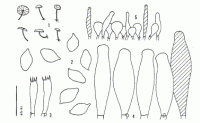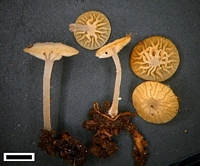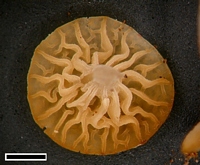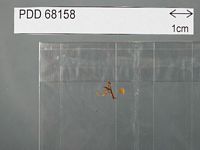|
 Gloiocephala gracilis Gloiocephala gracilis
BiostatusPresent in region - Indigenous. Endemic
Images (click to enlarge)
Caption: Fig. 3 (1-5). Gloiocephala gracilis Desjardin & E. Horak (PDD, holotype).- 1. Basidiomes.2.
Basidiospores.- 3. Basidia.- 4. Cheilogloeocystidia and caulogloeocystidia- 5. Pileipellis. | 
Caption: scale=2mm
Owner: J.A. Cooper | 
Caption: scale=1mm
Owner: J.A. Cooper | 
Caption: Dried type specimen
Owner: Herb PDD | |
Article: Desjardin, D.E.; Horak, E. (1997). Marasmius and Gloiocephala in the South Pacific Region: Papua New Guinea, New Caledonia, and New Zealand taxa. Bibliotheca Mycologica 168: 152 p.
Description: Pi1eus 3-8 mm diam, hemispherical when young, becoming convex or plano-convex in age, disc
neither depressed nor umbilicate, margin weakly plicate; surface dull, dry, minutely pruinose; at
first white overall, soon becoming pale grey, finally changing to pale brown. Texture
membranaceous; context very thin, white.- Lamellae broadly adnate to subdecurrent, subdistant (912) with 0-1 series of lamellulae, white; edges even, concolorous.- Stipe 5-7 x 0.5 mm, central,
equal, cylindrical, often curved, tough, minutely pruinose overall, non-insititious, base with short,
strigose, concolorous hairs attached to substrate; white overall or with the base becoming pale
brown in age.- Odor and taste not distinctive.
Basidiospores 5.5-7.0 x 3.5-4.0(-4.5) µm, ovoid to ellipsoid, smooth, thin-walled, hyaline, inamyloid. -
Basidia 18-22 x 5-6 µm, subclavate, 4-spored, unclamped.- Cheilogloeocystidia common, 40-60 x
10-14 µm, broadly fusoid to narrowly lageniform, subcapitate, thin-walled, hyaline or with yellow
contents.- Pleurogloeocystidia uncommon, like cheilogloeocystidia.- Pileipellis a hymeniform layer
of broadly clavate to globose, smooth, hyaline cells, 12-20 x 8-16 µm; with numerous
pileogloeocystidia interspersed, 20-40 x 6-8 µm, cylindrical-subcapitate to lageniform-capitate,
often with yellow contents.- Tissues inamyloid, non-gelatinous. - Caulogloeocystidia numerous, 30-45 x 7-10 µm, like cheilogloeocystidia. - Clamp connections absent.
Habitat: Habit, habitat and distribution.- Solitary, rarely cespitose, in groups on rotting wood in Nothofagus-Melicytus-Weinmannia forest. New Zealand.
Notes: Gloiocephala gracilis is characterized by the following features: small, plicate, white to pale brown
pilei; well-developed, subdistant lamellae; a white, pruinose, non-insititious stipe; fructification on
rotting wood; relatively small basidiospores; numerous subcapitate gloeocystidia with yellowish
contents on pileus, stipe and hymenophore; and the absence of clamp connections. Gloiocephala
gracilis belongs in sect. Gloiocephala, subsect. Gloiocephala in Singer's (1976) classification. The
new species is closely allied with G. alvaradoi Singer, an unclamped species described from
Argentina. Gloiocephala alvaradoi differs, however, in forming a white pileus, fewer lamellae,
longer, basidiopores (7.0-9.5 µm), much narrower pileipellis cells (3-6 µm diam versus 8-16 µm
diam in G. gracilis), and sporulates on wood of Alnus and Polylepis (fide Singer, 1976).
|